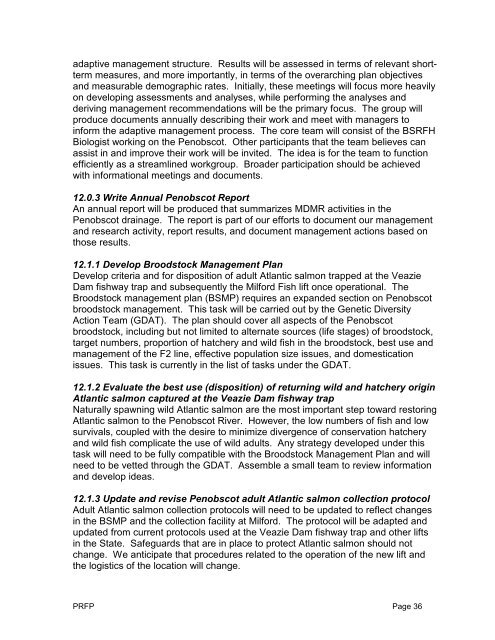Operational Plan for the Restoration of Diadromous Fishes to the ...
Operational Plan for the Restoration of Diadromous Fishes to the ...
Operational Plan for the Restoration of Diadromous Fishes to the ...
You also want an ePaper? Increase the reach of your titles
YUMPU automatically turns print PDFs into web optimized ePapers that Google loves.
adaptive management structure. Results will be assessed in terms <strong>of</strong> relevant shortterm<br />
measures, and more importantly, in terms <strong>of</strong> <strong>the</strong> overarching plan objectives<br />
and measurable demographic rates. Initially, <strong>the</strong>se meetings will focus more heavily<br />
on developing assessments and analyses, while per<strong>for</strong>ming <strong>the</strong> analyses and<br />
deriving management recommendations will be <strong>the</strong> primary focus. The group will<br />
produce documents annually describing <strong>the</strong>ir work and meet with managers <strong>to</strong><br />
in<strong>for</strong>m <strong>the</strong> adaptive management process. The core team will consist <strong>of</strong> <strong>the</strong> BSRFH<br />
Biologist working on <strong>the</strong> Penobscot. O<strong>the</strong>r participants that <strong>the</strong> team believes can<br />
assist in and improve <strong>the</strong>ir work will be invited. The idea is <strong>for</strong> <strong>the</strong> team <strong>to</strong> function<br />
efficiently as a streamlined workgroup. Broader participation should be achieved<br />
with in<strong>for</strong>mational meetings and documents.<br />
12.0.3 Write Annual Penobscot Report<br />
An annual report will be produced that summarizes MDMR activities in <strong>the</strong><br />
Penobscot drainage. The report is part <strong>of</strong> our ef<strong>for</strong>ts <strong>to</strong> document our management<br />
and research activity, report results, and document management actions based on<br />
those results.<br />
12.1.1 Develop Broods<strong>to</strong>ck Management <strong>Plan</strong><br />
Develop criteria and <strong>for</strong> disposition <strong>of</strong> adult Atlantic salmon trapped at <strong>the</strong> Veazie<br />
Dam fishway trap and subsequently <strong>the</strong> Mil<strong>for</strong>d Fish lift once operational. The<br />
Broods<strong>to</strong>ck management plan (BSMP) requires an expanded section on Penobscot<br />
broods<strong>to</strong>ck management. This task will be carried out by <strong>the</strong> Genetic Diversity<br />
Action Team (GDAT). The plan should cover all aspects <strong>of</strong> <strong>the</strong> Penobscot<br />
broods<strong>to</strong>ck, including but not limited <strong>to</strong> alternate sources (life stages) <strong>of</strong> broods<strong>to</strong>ck,<br />
target numbers, proportion <strong>of</strong> hatchery and wild fish in <strong>the</strong> broods<strong>to</strong>ck, best use and<br />
management <strong>of</strong> <strong>the</strong> F2 line, effective population size issues, and domestication<br />
issues. This task is currently in <strong>the</strong> list <strong>of</strong> tasks under <strong>the</strong> GDAT.<br />
12.1.2 Evaluate <strong>the</strong> best use (disposition) <strong>of</strong> returning wild and hatchery origin<br />
Atlantic salmon captured at <strong>the</strong> Veazie Dam fishway trap<br />
Naturally spawning wild Atlantic salmon are <strong>the</strong> most important step <strong>to</strong>ward res<strong>to</strong>ring<br />
Atlantic salmon <strong>to</strong> <strong>the</strong> Penobscot River. However, <strong>the</strong> low numbers <strong>of</strong> fish and low<br />
survivals, coupled with <strong>the</strong> desire <strong>to</strong> minimize divergence <strong>of</strong> conservation hatchery<br />
and wild fish complicate <strong>the</strong> use <strong>of</strong> wild adults. Any strategy developed under this<br />
task will need <strong>to</strong> be fully compatible with <strong>the</strong> Broods<strong>to</strong>ck Management <strong>Plan</strong> and will<br />
need <strong>to</strong> be vetted through <strong>the</strong> GDAT. Assemble a small team <strong>to</strong> review in<strong>for</strong>mation<br />
and develop ideas.<br />
12.1.3 Update and revise Penobscot adult Atlantic salmon collection pro<strong>to</strong>col<br />
Adult Atlantic salmon collection pro<strong>to</strong>cols will need <strong>to</strong> be updated <strong>to</strong> reflect changes<br />
in <strong>the</strong> BSMP and <strong>the</strong> collection facility at Mil<strong>for</strong>d. The pro<strong>to</strong>col will be adapted and<br />
updated from current pro<strong>to</strong>cols used at <strong>the</strong> Veazie Dam fishway trap and o<strong>the</strong>r lifts<br />
in <strong>the</strong> State. Safeguards that are in place <strong>to</strong> protect Atlantic salmon should not<br />
change. We anticipate that procedures related <strong>to</strong> <strong>the</strong> operation <strong>of</strong> <strong>the</strong> new lift and<br />
<strong>the</strong> logistics <strong>of</strong> <strong>the</strong> location will change.<br />
PRFP Page 36






